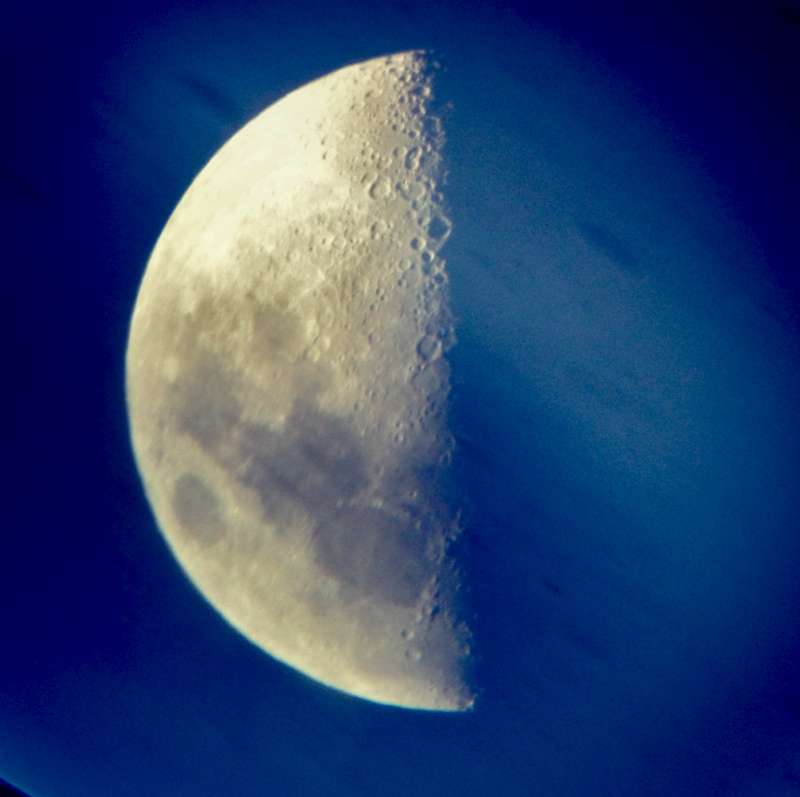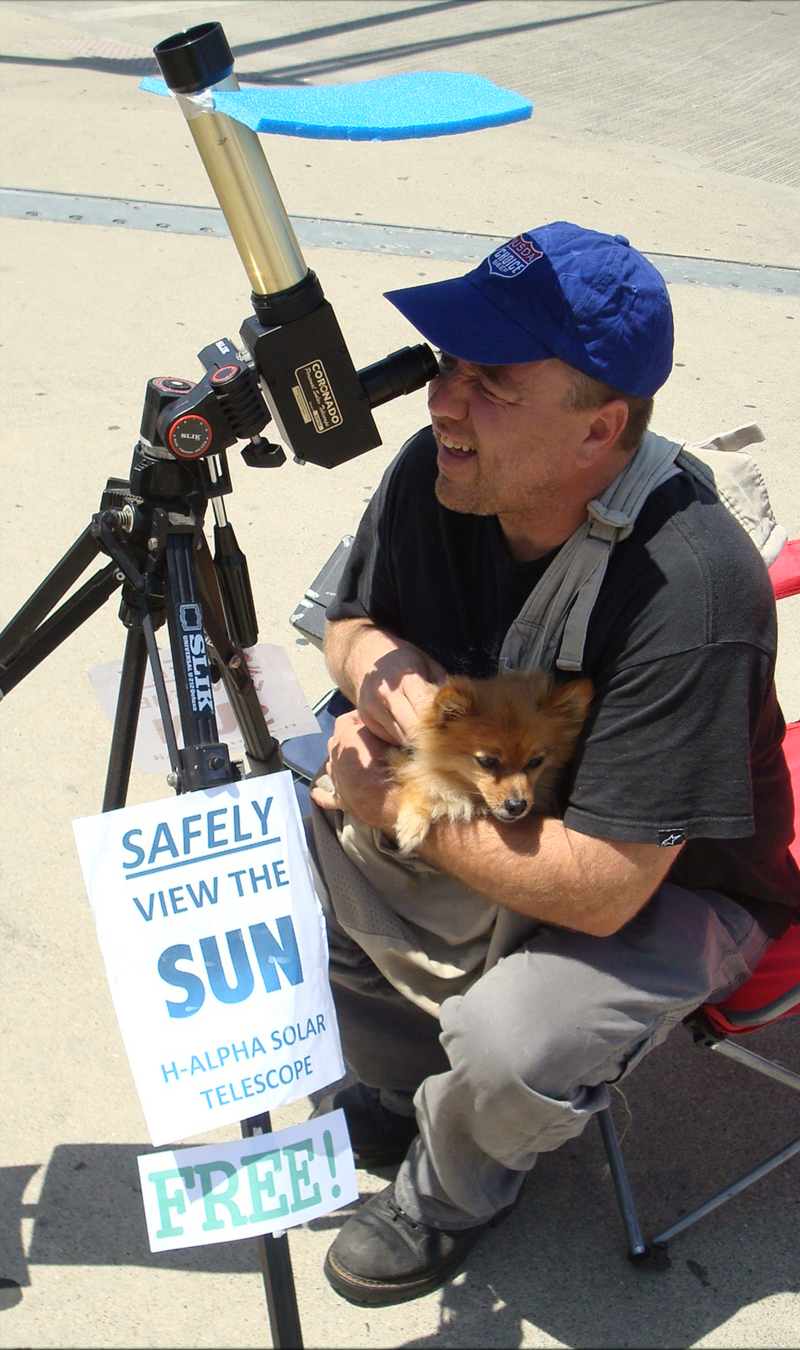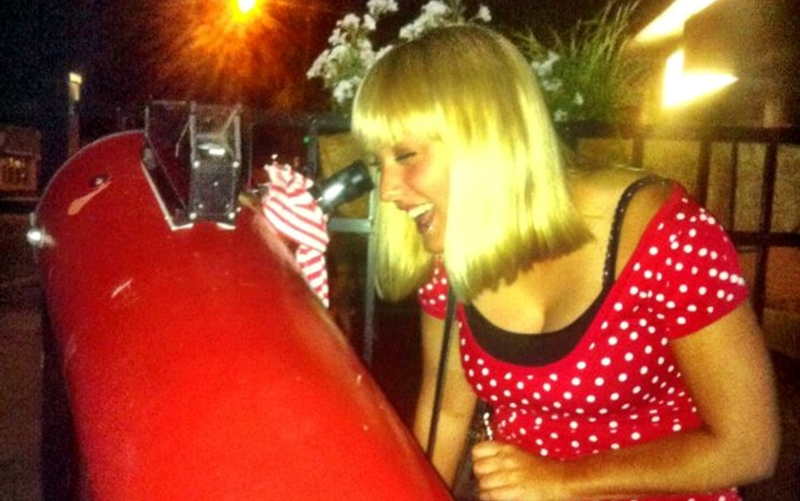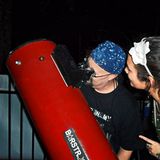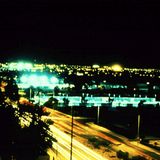
In a previous Telescope.com article, I gave a list of essential items needed to do urban/sidewalk astronomy. The list is good for any astronomy observing outreach, but best suited for light-polluted urban settings using a "public hands-on" approach.
So now you're ready to head out to the restaurant or pub patio, the coffee shop veranda, or just out on the sidewalk. What do you look at? City and business lighting may make it tough to see many stars in the sky. But really, all you need are two or three good things to view, and often there can be even more. Here's a list of the best objects to view from city locations:
1. The MOON: This is an easy, obvious target if it's the right phase-anything from about three days after New Moon to sometime around Last Quarter. While the Moon is hated by those hunting deep sky objects at a dark site, it's the object everyone wants to see in an urban setting. Binoculars are good for panoramas, especially if there are nearby trees and thin scattered clouds you can put in the FOV. The most modest scope can show amazing detail on the surface. It just blows people away, especially the craters-I'm always amazed they're so amazed by that. In larger phases, an adjustable polarizing filter can be a good thing to cut down the glare. I prefer using a wide-field eyepiece rather than tight-in magnification, so folks can track and follow easier when they run the scope-which I always encourage.
2. SATURN: The next-most-impressive object to the Moon. With a little scale on it, people will accuse you of pasting a picture in the scope. This is a good time to show them (if you're using a reflector) that there's just a mirror at the bottom and a small mirror at the top, bouncing light right into their eye-no tricks! They'll be especially impressed by any moons visible, and Titan, at least, almost always is. Like all objects, have a "cheat sheet" in hand or in your head with some basic facts, like size, distance, and number of moons. Depending on your scope, maybe a little more magnification is in order, but not TOO much: you want to make sure it's easy to track.
3. JUPITER: The "other" impressive target. Cloud bands and the Galilean moons are always visible unless conditions are terrible. People love watching the moons move around through the evening, and they're amazed that they can be spotted even with binoculars. This is a great object to show through both the binos and your scope. Thick haze can ruin it, though, so wait it out or pack it in! If at a tavern, and you're a bit of a gambler, an entertaining "wager" can be to see if your patron can name any or all of the Galilean moons. Don't believe they never can-I've lost this bet before, requiring all four. Pay up if you lose! As always, know which moon is which: this is very easy to do with any number of apps, tweets and sites which will keep you informed. Jupiter's Great Red Spot is not often visible from urban settings, even if face-on. But it's good to know when it is anyway, because someone will ask. And who knows, maybe you will be able to see it.
4. The SUN: There is no more-impressive object than our closest star. Obviously exclusively a daytime target, this requires a white-light solar filter or a hydrogen-alpha scope. It's a stand-alone target for daytime outreach, other than the Moon or Venus, which can sometimes be seen depending on their location in the sky. The H-alpha scope is by far the best way to go, as most people have never seen this view at all unless it's in a photo in a magazine or online. All you need is a clear day, the time and inclination to do it! This is THE target for daytime festivals and public events. It's also the one where I tend to do the aiming, rather than allowing the patron to do so, since it's tougher than aiming a Dob, and the H-alpha scope tends to be a little more fragile and pricey.
5. ORION'S SWORD/ORION NEBULA: For a light-polluted place, Orion's entire Sword through astronomical binoculars is the better of this pair of targets. While the Sword is probably visible naked-eye, the amount of stars, and the small view of the Orion Nebula in the middle, is a very easy and impressive sight from all but very bright places. If it's a bit darker, the Orion Nebula through a scope can be very good as well, but often it's not; it'll never look like that OIII filter view from your dark site. But I've had a viewer be able to see the four main Trapezium stars from a tavern patio; not bad!
6. PLEIADES: This is a real crowd-pleaser through binoculars, and of course too large to fit into any but a rich-field scope. People can see it in the sky, although they may have to shield their eyes from nearby lights. And the view in binoculars is simply stunning. It's a challenge to see how many stars they can see naked-eye (I can usually only manage five myself) versus the binocular view (generally over thirty if they take their time). And the various names of this object are of great interest to most: many have heard of the Seven Sisters if they haven't heard of the Pleiades, but most have NOT heard its name "Subaru", and are pleased to finally learn why those cars have those stars in the logo.
7. ALBERIO: A good object, easy to find at the right time of year, and wonderful for showing color to those who wish to see some. Many are disappointed by the lack of color in images, having imagined the view through a scope is like a picture in a magazine. This is great for showing color due to its blue and yellowish components. And it allows some conversation about the Milky Way, (which probably is not visible from the city), and the "Northern Cross", Cygnus.
8. BEEHIVE CLUSTER: Much like the Pleiades, this is an extremely pleasing binocular object. Often viewers will want the scope aimed at these clusters as well, and that's fine-they can steer around and see more detail, but they'll get a very visceral lesson in object size. That can lead to a great conversation on best viewing methods: naked-eye for meteors and aurora, binos for very large objects, scopes for objects from low-magnitude (large clusters, many nebulae) to high-mag (planets, planetary nebulae).
9. MARS (SOMETIMES): People always want to look at Mars, and sometimes it does look good; when it's close enough to Earth and your scope can give it enough scale. A lot of the time though, it's not very impressive. But when it is, and you can get enough magnification to make it worthwhile, folks can be extremely impressed to see a lighter polar cap and surface mottling. And it's always better than Neptune or Uranus, and someone cracking wise will always ask to see the latter.
10. HYADES: More huge star-cluster fodder for binoculars. Easy to spot via Aldebaran in proximity to Orion and the Pleiades, your viewers can be very impressed by the number of stars and the amount of sky it covers. I'm going to throw in the northern Perseus star fields as well, when they're visible, and also scanning many areas of the summer Milky Way.
BONUS OBJECTS: The International Space Station and Iridium Flares. www.heavens-above.com is a great place to find out when and where, although it's not the only site doing this. And even though the ISS is just a bright white light slowly crossing the sky on a good day, people LOVE to see it. However, it's generally too hard for people to track successfully, although it shows structure in large binoculars and a scope. You can let them try if you wish. The brighter Iridium flares are impressive due to their predictability and the fact that they happen frequently, about two to four times per night; people are pleased to find out they can learn easily when and where they'll be visible. Then, they can impress the neighbors by saying "the aliens are going to signal me from this part of the sky at such-and-such a time tonight." New respect in the hood!
BELIEVE IT OR NOT, PROBABLY NOT: The next objects are usually NOT very much to look at from an urban setting in a scope 8" or less. You might think they'd be, but in my experience I've mostly given up on them. For a darker site, certainly; light-polluted urban site, not really, but they are worth a try. Your mileage may vary, depending on your scope and the exact conditions from your viewing stage.
M13, Lagoon Nebula, Swan Nebula, Andromeda Galaxy, M81/82, Leo Triplet, Comets, unless they're quite bright, say 5th magnitude at least.
If you've got an obvious object I missed in this list, please let us know in the comments. Hey, I'm not a scientist-I just play one on bar patios! Until next time, eyes to the skies!
CAUTION: Never look at the Sun, either directly or through a telescope or binocular, without a professionally made protective solar filter installed that completely covers the front of the instrument, or permanent eye damage could result. When using a truss tube telescope to view the Sun, both a properly fitting solar filter and light shroud are required.
Tony Miller, aka "Duke Skygawker," is a native Ohioan who watched the sky from an early age but never took up astronomy as a hobby until well into his 40s. His professional background is in broadcast media, journalism, and performing arts, which have certainly influenced his involvement in astronomy outreach. He can be found on Twitter (@Barstronomy) and on Facebook (Duke Skygawker), as well as at Columbus, Ohio music venues and rural dark-sky sites.



